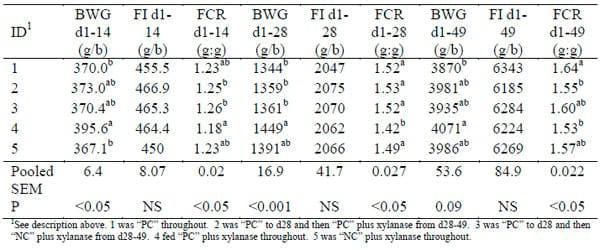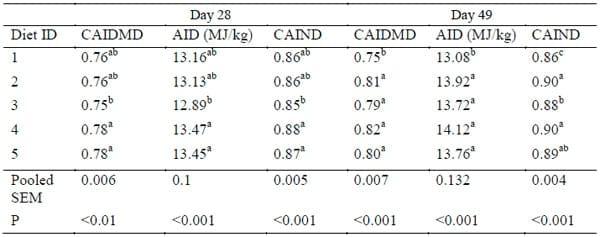I. INTRODUCTION
Exogenous xylanase has been routinely added to non-ruminant diets for more than 20 years. In diets based on cereals such as wheat and rye, the mechanism of action is likely to centre on viscosity reduction and improved diffusion of nutrients in the intestine. Though this mechanism is almost certainly involved, interactions with fats and a reduction in the presence of bacteria in the small intestine following xylanase addition, may also be important. The effect of exogenous enzymes on the microbial populations in the avian hind gut has been considered for many years. The hydrolysis of structural fibre by exogenous xylanase may provide xylo-oligomers which have been shown to increase bifidobacteria populations in the caeca and FCR improvement (Courtin et al., 2008). These oligosaccharides are partially fermented in the caeca and colon yielding a range of volatile fatty acids resulting in changes in the profile of short-chain fatty acids in the distal GI tract. These fatty acids have some energy value for the host animal but perhaps more importantly reduce pH, restrain the proliferation of putrefactive microorganisms, encourage the proliferation of enterocytes and may directly mediate gastric emptying, perhaps via the same infrastructure involved in the ileal brake mechanism.
II. EXPERIMENTAL DETAIL
A total of 1500 Cobb 500 day-old male chicks were obtained from a commercial hatchery and randomly allocated to one of the five dietary treatments in a completely randomised design. Each treatment was replicated twelve times with twenty-five chicks per replicate pen. At 28 and 49 days of age, three birds per pen were euthanized for the purpose of digestibility measurements and the contents of the distal half of the ileum content were collected. Ileal contents were immediately frozen at -18ºC prior to being freeze-dried and ground to pass a 0.5mm screen.
Diets were based on wheat and soybean meal and basal diets contained the following in the starter (1-14 days), grower (15-28 days) and finisher (29-49 days) phases; energy 12.80, 13.10, 13.40 MJ/kg; digestible Lysine (dLys) 12, 9.5, 8.6 g/kg; Ca 9.5, 8.5, 8.0 g/kg and digestible P (dP) 4.5, 3.6, 3.3 g/kg. There were five treatments; treatment 1 was a basal diet. Treatment two was identical to treatment 1 except xylanase was included from day 28 only. Treatment three was as treatment two (xylanase fed from day 28) but the diet from day 28 was energy reduced (less 0.25MJ/kg). Treatment four was identical to treatment one except xylanase was included from day 1. Treatment 5 was as treatment four (xylanase fed from day one) except the diet from day one was energy reduced (less 0.25MJ/kg). All diets were steam pelleted at 80 ºC in a Palmer pelleter mill with a steam pressure of 150 kDa and a seven second conditioner residence time. Acid insoluble ash (Celite; AIA) was used at 20 g/kg as an indigestible marker. The xylanase enzyme (Econase XT) used in the current study was supplied by AB Vista Feed Ingredients (Marlborough, UK). This xylanase preparation contained 160,000 units/g of endo-1,4-β-xylanase activity (EC 3.2.1.8).
The gross energy (GE) of diets and lyophilized digesta were determined using a Parr 1281 adiabatic bomb calorimeter (Parr Instrument Company, Moline, IL, USA). Nitrogen concentration of samples was determined by the Dumas method using a FP-428 nitrogen analyser (LECO® Corporation, St. Joseph, MI, USA). The acid insoluble ash component of dried diets and ileal digesta samples were determined allowing the calculation of apparent ileal digestibility coefficient of N and energy.
All data were exported to JMP v.9.0 (SAS Institute, Cary, NC, USA) and subjected to analysis of variance. Means were separated by Tukeys LSD and were considered significant at P<0.05.
III. RESULTS
The effect of xylanase addition on broiler performance is presented in Table 1. There was an improvement (P<0.05) in bodyweight gain associated with the addition of xylanase to the control diet (treatment 1 versus 4). The birds that received the energy-dilute diet supplemented with xylanase had performance equivalent to the control group (P>0.05, treatment 1 versus 5). Diet 5 returned an FCR not different from the control group.
During the period 1-28 days, there was a significant improvement in bodyweight gain with the addition of xylanase to the control diet and this was reflected in a significant improvement in FCR (P<0.05). However, the dilution of metabolisable energy by 0.25 MJ/kg (diet 5) returned an intermediate performance that was not different from the control.
Terminal bodyweights were significantly higher for the birds that received xylanase throughout the trial (diet 4) compared with those that received the industry standard control diet. The combination of energy dilution and xylanase addition (diet 3 and diet 5) resulted in performance equivalent (P>0.05) to the industry standard control diet (diet 1). Feed conversion ratio was improved by the addition of xylanase on an 'over-the-top' basis (diet 4 vs. diet 1). The addition of xylanase from d28 with no energy dilution resulted in an improvement in FCR and this tended toward significance compared with diet 1 (P<0.05).
When xylanase was added in combination with a reduction in energy density there was a muted benefit on FCR but performance was equivalent (P>0.05) to the control diet (diet 1).
Table 1 - Influence of xylanase addition to a wheat/soy-based diet on broiler performance

The effect of xylanase addition with and without energy dilution on the ileal digestibility of energy, dry matter and nitrogen is presented in Table 2. On d28, the addition of xylanase, irrespective of whether a corresponding energy dilution was applied (treatments 4 and 5), resulted in an increase in ileal digestible energy of around 0.3-0.4MJ/kg. This increase was significant when treatments 1-3 (which were identical to d28) were contrasted to either treatment 4 or 5 (P<0.05, contrast not shown). The dilution of dietary energy (diet 5 vs. diet 4) had no detectable effect on ileal digestible energy at d28 (P>0.05). Similar effects were observed with the apparent coefficient of ileal nitrogen digestibility where there was an improvement (P<0.05) when diets 1-3 were contrasted against either diet 4 or diet 5. On d49, xylanase addition (either with or without an energy density dilution) improved ileal digestible energy (around 0.9MJ/kg; P<0.001) and ileal nitrogen digestibility coefficients (around 4.6%; P<0.001) compared with the xylanase-free control diet.
Table 2 - Influence of xylanase addition on the coefficient of apparent ileal dry matter digestibility (CAIDMD), apparent ileal digestible energy (AID) and the coefficient of apparent ileal nitrogen digestibility (CAIND) at d28 and d49
IV. DISCUSSION
A major conclusion from the present experiment is that the timing of addition of exogenous xylanase is critical to the outcome, especially in the young bird as is the effect of fat inclusion in the diet.
Rosen (2002) reported the results of a holo-analysis of 1322 independent peerreviewed experiments where xylanase was added to broiler diets. In this analysis, a significant 'not day old' term emerged where the overall efficacy of xylanase was muted when xylanase was introduced several days, or weeks, after the experiment began and axiomatically enhanced when xylanase was introduced immediately post-hatch. It is conceivable that the introduction of xylanase immediately post-hatch results in the gradual emergence of a distal gut microbial community that has an advantageous profile for nutrient recovery and GI tract integrity.
The interactive effect of dietary fat and exogenous xylanase has been reported and appears to have been influential in the present study. Cowieson et al. (2010) found that the removal of 20g/kg vegetable oil from a broiler starter diet in order to accommodate the anticipated energy effects of supplemental xylanase resulted in a reduction in ileal amino acid digestibility of around 4%. The authors speculated that the removal of dietary fat altered the rate of passage of feed in the GI tract, perhaps mediated via gastric residency.
Finally, the ileal brake mechanism may play an important role in the efficacy of xylanases. Modern day broilers may have a feed passage rate that is too rapid for optimal digestibility of nutrients and thus some decrease in transit rate may be beneficial. One hormone, amongst many of which may be involved in this process, is Peptide YY (PYY) and has been shown to delay gastric emptying (Savage et al., 1987). In various species, PYY has been shown to be released in response to dietary fibre and fat. Early experiments with broilers have shown that those fed diets containing xylanase have significantly higher levels of plasma PYY (Masey O'Neill et al., 2012). Thus, the displacement of dietary fat with exogenous xylanase, perhaps acutely but not uniquely in the neonate (Cowieson et al., 2010), may inadvertently reduce the overall efficacy of the xylanase
It can be concluded that exogenous xylanase is an effective way to reduce FCR and enhance BWG of broilers. Optimum response was achieved by the addition of xylanase from d1 (immediately posthatch) without dilution of dietary energy. However, inclusion alongside dietary energy reduction of 0.25MJ/kg resulted in performance equivalent to the control.
REFERENCES
Courtin CM, Broekaert WF, Swennen K, Lescroart O, Onagbesan O, Buyse J, Decuypere E, Van De Wiele T, Marzorati M. Verstraete W (2008) Cereal Chemistry, 85, 607-611.
Cowieson AJ, Bedford MR, Ravindran V (2010) British Poultry Science, 51, 246-257.
Masey O'Neill HV, Haldar S, Bedford MR (2012) International Poultry Scientific Forum, Atlanta, Georgia.
Rosen, G. (2002) In: Recent Advances in Animal Nutrition. Garnsworthy, P.C. & Wiseman, J. (Eds). Nottingham University Press, Nottingham, UK. Pp 89-103.
Savage AP, Adrian TE, Carolan G, Chatterjee VK, Bloom SR (1987) Gut. 28, 166-170















.jpg&w=3840&q=75)